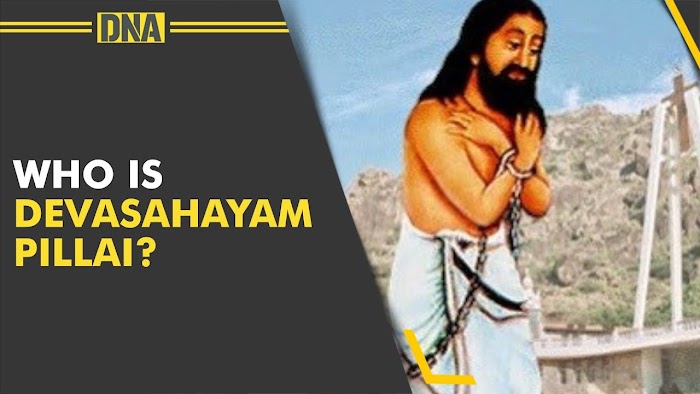Lazare Devasahayam is the only non-European saint among the ten to be canonized by Pope Francis on Sunday, May 15 at St. Peter's Basilica. Blessed Lazare Devasahayam Pillai (1712-1752) was a Hindu officer who converted to Catholicism.
He is the finance minister of the kingdom of Travancore, will be the eighth Indian canonized in the history of the Catholic Church, but this is the first Indian layman to be canonized.
Lazare Devasahayam was born on April 17, 1712 in a village south of the Travancore kingdom, in the extreme southwest of India, which stretched between the present-day states of Kerala and Tamil Nadu. Coming from a high caste and Hindu family, he was highly educated, especially fluent in languages, and in traditional martial arts.
Friendship with the Netherlands
Blessed Ladare was a traditional hinduist, faithful to his roots, he rose rapidly in his career and was named "Nilakandan", minister of the kingdom and official of the royal palace, in charge of the treasury. and finance.
In 1741 when he was only 29 years old, the Dutch attack on southern India was defeated with the victory of King Marthandavarma at the port of Colachel. Many officers of the army of the United Provinces – as the Netherlands was called at the time – were taken prisoner, including the Catholic company captain Eustache de Lannoy.
The king of Travandore, who appreciated officer Lannoy's reputation as a brilliant military strategist, released him and made him general of his own army, after which he helped modernize the army. team.
He also erected fortifications. His partnership with the finance minister Nilankandan developed into a personal friendship, the suffering of the Dutch officer in exile echoing the minister's loneliness in the face of his exclusion. family does not believe in love.
Returned and persecuted
Eustache de Lannoy then explained his Catholic faith to Ladare, specifically telling Ladare stories from the Bible and about the suffering of Job, supposedly righteous. Then the minister of Nilankandan understood the Christian faith and for that he was angry with the king when he saw that history had assimilated Christianity with the colonial threat.
Finally, a Jesuit baptized him on May 17, 1745, taking his biblical name Ladare, which translates as "Devasahayam" in the Indian language. His wife was also baptized, and both husband and wife were active in mission. But the Hindu monks were worried and denounced to the king.
On the official page of the Congregation for the Causes of Saints reports: “He first refused to worship the Hindu gods in the palace and distanced himself from Hindu religious festivals, thus causing many officials not to accept the offer. His teachings on the equal rights of all peoples, transcendence of class, and friendship with those of the lower classes, something forbidden for a person of high caste."
Tortured and humiliated
Finally, on February 23, 1749, the king had him arrested. The king wanted to make him renounce the Catholic faith, but to no avail, the king had him publicly tortured. He spent a long time on Calvary, suffering terrible humiliation, following Christ's example on the way to Golgotha.
In particular, he was tied to a tree for seven months, threatened by wind, rain, hunger, thirst, and wild beasts. But he never denied his faith and this humiliating time of captivity was also a time of evangelism: many people visited him at the foot of the tree, they received prayers and blessings, and the the guards guarding him were kind to him, even inciting him to flee.
The king transferred him to a secret prison and finally on January 14, 1752, he was executed on a hill when he was 39 years old. His last words: “Lord, save me.” His body was left in the forest by the soldiers so that it would disappear, but finally, five days later Catholics found the body and the body was confirmed, buried in the Church of Saint Francis Xavier Kottar , the current cathedral of the diocese of Kottar, State of Tamil Nadu.
Eighth Indian canonized
His reputation for holiness spread rapidly in India, he was beatified on December 2, 2012 in a ceremony celebrated by Cardinal Angelo Amato, prefect of the Congregation for the Causes of Saints at the time, in the presence of of about forty Indian bishops, 2,000 priests, consecrated religious and a large number of laity.
The miracle chosen to canonize him was that the fetus of an Indian woman at 20 weeks of pregnancy was revived. The decree recognizing miracles was issued by Pope Francis on February 21, 2020.
His canonization has had a remarkable effect, especially given the many attacks that Christians in India have suffered from the most extreme movements of the Hindu nationalist party that is in power at the federal level. .
Devasahayam Pillai will be the eighth Indian to be canonized, the other saints are all monks. The most famous person is still Mother Teresa, who is originally from Albania, but is considered Indian because she has Indian nationality. Seven other Indians have been beatified, and according to the Church Asia agency, India has at least 11 "respectable degrees" and more than 40 "servants of God".
Source: Vietnamese Catholic News



